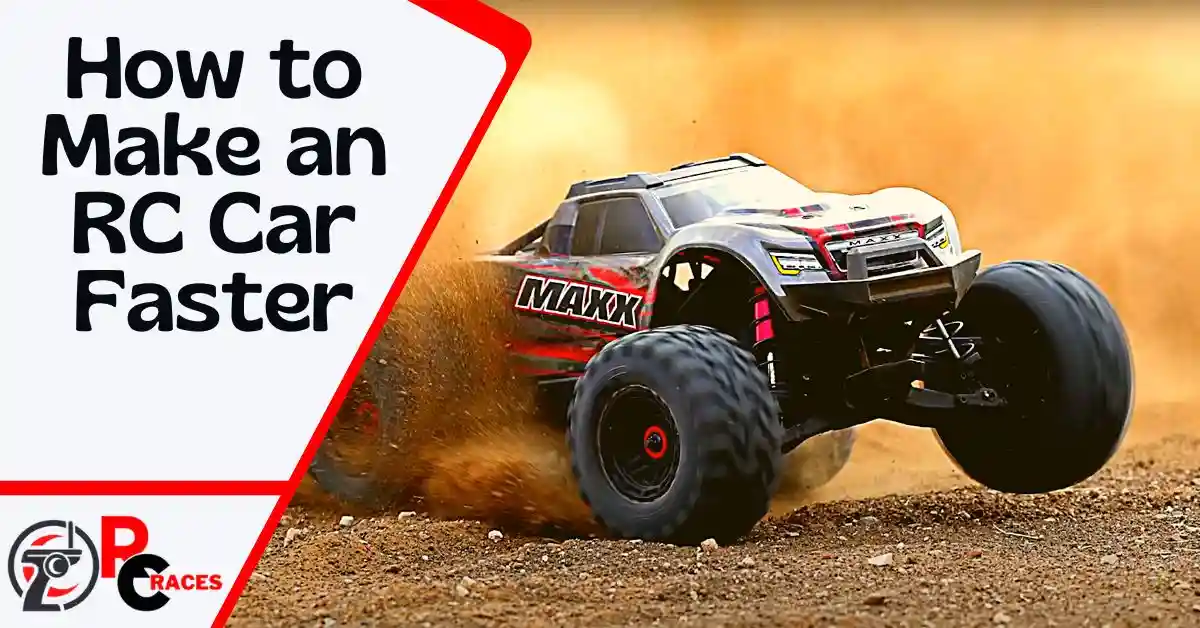Once, the only way to enhance the speed of a radio-controlled (RC) car was by purchasing a faster model or constructing a new one from scratch. However, the time has changed, and modern RC cars are undergoing advanced modifications. You can now make your RC car faster, even without massive changes.
So, how to make an RC car faster?
You can do it in several ways. But the common ways to make your RC car faster are adding a powerful battery and motor, changing the gear ratio, replacing old bearings, optimizing the suspension system, and trying new tires for the car.
This article has a further explanation of each of the points. Would you like to learn more about making an RC car faster? Read the rest and explore.
Why Do RC Car Owners Want to Make Their Vehicles Faster?
Everyone wants to see their RC cars moving faster. But this is not the only reason that influences RC car owners to make their cars faster. Check out the following points to learn a variety of reasons behind them.
- Undoubtedly RC car competition is the primary reason behind making a car faster. Enhancing an RC car’s speed gives them an advantage and wins races.
- Many RC hobbyists like to customize their RC cars and make them unique. Making RC cars faster is a common customization that is also linked to owners’ personal satisfaction.
- RC enthusiasts enjoy the thrill of driving fast. To enjoy speed, they often modify their cars to go as fast as possible.
- Another reason behind improving the speed is to make RC cars as close to real cars as possible. People in the community believe that speed helps achieve this realism in terms of appearance and performance.
7 Ways to Make Your RC Car Faster
1. Install a Powerful Battery.
The most common technique people often apply to make RC cars faster is installing a new battery, which is more powerful than the built-in one. It works because the battery of an RC car plays a key role in its speed.
In general, more voltage means more speed, which influences RC owners to replace the integrated batteries in their cars. But you must be careful since every battery will not work for every RC car. Each car has a system with a defined voltage limit.
So, before replacing the built-in battery with a powerful one, confirm that your RC car’s motor is capable of handling the additional energy from the battery.
2. Upgrade to a High-Performance Brushless Motor.
Beginners often ask which type of motor is the best for an RC car. The answer is both have a strong presence in the RC industry. But a brushless motor is the clear winner when you talk about speed.
They are considered faster and more efficient than brushed motors. Technically, brushless motors have less friction, which allows them to run cooler and smoother. These motors also have higher RPMs, which clearly means higher speeds.
Though the speed depends on many factors, a brushless motor will definitely make an RC car faster. So, you can upgrade your RC car today with a high-performance brushless motor from the many options available in stores.
3. Adjust the Gear Ratio.
The speed of an RC car can dramatically increase after a simple adjustment in the gear ratio. You can easily determine an RC car’s gear ratio by dividing the number of teeth on the spur gear by the number of teeth on the pinion gear.
If the result after calculation represents a higher gear ratio (shorter), it is ideal for users looking to increase the speed of the RC car. However, the optimal gear ratio always depends on the specific needs and design of the RC car.
You can adjust the gear ratio and make your RC car faster in two ways. Either you need to change the size of the gears in the drivetrain, or you have to change the number of gears in the transmission.
The best practice to increase the car’s speed is choosing bigger spur gears than the standard, providing more acceleration.
4. Use Ball Bearings.
Sometimes a small change makes a big difference. The following technique will prove the fact again. Though bearings remain unnoticeable, using high-quality bearings can improve an RC car’s overall performance and efficiency.
Ball bearings have less friction, allowing a car to run smoothly with less resistance. It also improves the speed and acceleration of your car. If your RC car comes with a different bearing type, you can replace them with ball bearings for extra speed.
The car’s overall speed depends on several mechanisms. But ball bearings are one of the aspects you should consider when trying to make your RC car faster.
5. Optimize the Suspension System.
Many RC hobbyists optimize their car’s suspension systems to make them faster and look cooler. A well-designed suspension system absorbs shocks and vibrations from rough terrain and provides a smooth ride. Thus it helps minimize friction and reduce resistance, allowing the car to maintain its speed. A good suspension system also optimizes the car’s weight distribution, boosting its speed.
Now the question is, which suspension system is good for speed? According to experts, coil spring suspension with a caster angle will make your RC car faster. This combination provides a balance of stability and responsiveness, a good setup for additional speed.
6. Choose the Tires with the Right Thread.
Have you noticed that racing cars are equipped with plain pattern tires? There is a secret that these tires don’t catch much dirt when driving, which is good for better acceleration and steering.
The replacement of old tires of your RC car can increase the speed suddenly. But you need to be careful about which one you choose. For example, tires with smooth treads provide minimal rolling resistance and maximize speed. They are more suitable for smooth surfaces such as asphalt.
Moreover, directional tread tires with a V-shaped pattern are designed to provide maximum grip and stability in straight-line acceleration. They are also fantastic options for high-speed driving surfaces.
7. Remove Extra Weight From The Car.
Every gram of weight is counted when increasing the RC car’s speed. Removing extra weight from a car that the motor has to carry will make it lighter and improve the speed. In some cases, reducing excess weight will make it easier to control and maneuver the car.
You can use a body, chassis, and battery of the RC car made of lighter materials. Using lightweight wheels and tires also helps reduce the car’s extra weight.
But be careful not to remove too much weight because it can badly affect the car’s balance and stability. Besides, you should never remove the safety components of an RC car. Here the key is to balance between reducing weight and maintaining functionality.
Frequently Asked Questions
What is the average speed of an RC car?
The speed range of average RC cars is from 20 to 50 mph. However, faster models can reach speeds of up to 70 mph. A few customized RC cars even can attain a speed of 100 mph.
What factors impact the speed of an RC car?
The speed of an RC car can be influenced by several factors, including the type of motor, gear ratio, suspension system, tire and wheel choice, body weight, battery type, driving surface, and so on.
Is a high or low gear ratio better in an RC car?
A gear ratio simply means how fast a car goes. If the gear ratio is high, the car will go fast but will start running slowly. If the gear ratio is low, the car’s speed will be slower, but it will begin to run quickly.
Final thought
Making an RC car faster involves a variety of factors. You may need to experiment with different components and settings to find the desired speed for a particular driving surface and style. The above techniques are widely practiced among RC car owners to improve the speed and overall performance of their vehicles. So, remember that patience and experimentation will help you find the hidden gems in the RC world.


